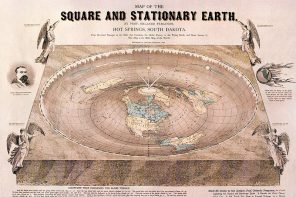In a thought-provoking post on RD just before the weekend, Yoni Pasternak highlighted some of the enchanted language that has been associated with CERN’s announcement of a Higgs boson-like particle discovery. The Higgs boson has been labeled the “God Particle,” and numerous scientists and journalists have described the Large Hadron Collider (LHC) as a “magical” device. If news about the Higgs boson has struck you as esoteric and confusing you are not alone, but the video embedded in Pasternak’s post offers a nice primer.
As Pasternak points out, even this explanatory video is full of magician’s hats and pink elephants. The fact that scientists themselves are using this vocabulary, he argues, “is a sign of the utility that these supernatural concepts still maintain” for describing our universe.
The use of supernatural concepts to describe the Higgs boson has been hotly debated ever since CERN’s announcement. Over at io9, Dave Goldberg makes all the best arguments against it. The “God Particle” was coined by Leon Lederman in a book detailing how essential the Higgs is for the Standard Model of Physics. The press subsequently took this idea and ran with it, Goldberg argues, in yet another example of savvy-science-promotion gone awry. For Goldberg and others, supernatural language is a tactic scientists use to communicate complicated ideas to laypersons such as friends, journalists, and the politicians who control budgets.
This position hits a wall when it has to account for the excitement and wonder that you hear in CERN physicists’ voices. In the video, it is clear that Daniel Whiteson isn’t translating hyper-rational ideas into supernatural terms. Translation assumes two distinct and separate languages, but Whiteson threads multiple vocabularies together, including mathematics, physics, and cultural metaphors. Words like “magic” are threaded throughout his speech quite naturally, affirming Yoni’s suspicion that supernatural concepts are useful for describing “those very features of our universe that science has supposedly laid bare.”
Yet there is still something that goes unaccounted for in both Goldberg and Pasternak’s accounts: the sheer scale of the Large Hadron Collider and the knowledge that is being produced there. Try to imagine, for just a moment, that you are traveling to another planet to study the people who live there. When you arrive you discover the largest machine ever built, a 17-mile oval tunnel filled with thousands of high-powered magnets. The tunnel is purified into a vacuum as empty as interplanetary space, and then beams of invisible matter are shot towards each other at 99.9999991% the speed of light until they collide, causing explosions 100,000 times hotter than their sun.
When you ask these elite practitioners what they are doing, they respond that it’s to observe an excitation of an everywhere-permeating field that gives the world its substance. The hope is that this excitation, which takes the form of a barely observable particle, will reveal new truths about the underlying forces that produce their visible world. When you returned, would “science” or “religion” alone be a sufficient category for describing what you saw?
When it came time to analyze Whiteson’s speech, it was clear that translation was a bad model: by assuming that there must be two clear and distinct languages, it overlooked all of the interesting hybrids to be found in between. Arguing over the supernatural implications of the Higgs boson is, I think, a translation problem. The CERN labs are full of science and metaphysics, rationality and intuition, analysis and wonder. Enchanted language isn’t simply a holdover or a distortion of the press; it’s one of the many elements that circulate within one of our planet’s most venerated spaces.




